Data support the hypothesis that BCG vaccination reduces the severity of the COVID-19 (hereafter referred to as the BCG hypothesis). The causal relationship between BCG and the COVID-19 is expected to become clearer in the future, and I would like to investigate the possibility of this causal relationship in my own way, formulate a hypothesis, and organize it.
I am not an expert in medicine, biology, or immunology, so the following description may contain parts that are professionally inaccurate. If you want to know more, please check the information sources described by the experts. This article has not been reviewed by an expert at this time. Any comments from experts would be appreciated. This article does not recommend that BCG be attempted in the general hospital for the prevention of COVID-19 infection for purposes other than conventional tuberculosis prevention.
What has been revealed about the death toll of the COVID-19
Mortality in statistics
There is a significant difference in mortality per unit of population in countries where BCG vaccination is mandatory, where it was mandatory in the past, where it is no longer mandatory, and where it is no longer mandatory.
There is a significant difference in mortality by BCG strain type: BCG Tokyo has the lowest mortality rate, followed by other BCG strains; BCG-naïve countries have higher mortality rates. (*1-1, 1-2)
Trends in COVID-19 infections
It has been observed that the following infectious trends of the COVID-19 are different from those of normal infections.
- The COVID-19 includes a certain percentage of people who are infected but don't show any symptoms.
- There may be respiratory abnormalities without a fever.
- Even when infected, the rise in antibodies may be gradual.
- Even if you get infected and recover, your antibodies may fall off.
What I want to investigate
I investigated the hypothesis that BCG is effective against the COVID-19 and why older strains such as BCG Tokyo are more effective against the COVID-19 than other strains, mainly from the viewpoint of immunology, as follows.
Immunity and BCG
Immunity is the ability to keep one's body normal by attacking bacteria and viruses that have invaded the body as abnormal substances.
The human immune system is divided into "innate immunity" and "acquired/adaptive immunity". Innate immunity refers to immunity that a person is born with, while acquired immunity refers to immunity acquired after birth through infection or vaccination. The general flow of a person's immune response is as follows.
(1) Pathogens enter the body and innate immunity is activated (macrophages, dendritic cells and mast cells fight against pathogens).
(2) T cells proliferate after stimulation by foreign proteins (collectively called antigens) of foreign pathogens, and after eliminating pathogens, some of them differentiate into antigen-specific memory T cells. These memory cells remain, which allows for a rapid immune response when re-exposed to pathogens.
When we recognize a pathogen in such an immune response, we release substances called cytokines to call on cells to help us attack the pathogen. There are various types of cytokines such as interleukin (IL-n) and IFNγ, and in the case of innate immunity, cytokines such as TNF-α and IL-1 are produced.
It is said that BCG vaccine stimulates natural immunity, which is a state of being trained to make it easier for natural immunity to work, and this may take root as a long-term memory. This is called training immunity.(*2)
Mechanisms of viral infection and onset
The following is a brief description of how infection with a new type of coronavirus, an RNA virus, can lead to serious illness.
The steps of viral infection and propagation
(1) More than a certain number of COVID-19 viruses enter the body through droplets or contact (*3)
(2) The virus that enters the body adsorbs the receptor called ACE2 in the body's cells.
(3) The viral envelope fuses with the cell, and the viral protein and nucleic acid (RNA) enter the cell.
(4) Breaks down the protein that encases the viral RNA and releases the RNA.
(5) Replicate the released RNA.
(6) Viruses replicate with replicated RNA and proteins.

Viral uptake and infection occur mainly in the upper or lower respiratory tract, and proliferation occurs in the lungs from the lower respiratory tract onward and in organs with ACE2 receptors. During the process of proliferation, natural immunity is triggered and cells such as macrophages in the body attempt to phagocytose the virus. At the same time, macrophages release substances called cytokines to get support from other cells, activating immune cells (such as killer cells and antibodies). Normally, phagocytosis by innate immunity leads to a decrease in viral cells and healing, but if this cannot be suppressed, cytokines are abnormally activated by other substances, causing a state of inflammation (this is called a cytokine storm). A cytokine storm is a condition in which "release of cytokines" → "activation of immune cells" → "release of cytokines" are repeated and become abnormally active. It eventually leads to respiratory distress and acute respiratory distress syndrome (ARDS).
BCG-induced immune response
There are various pathogens and viruses in the world and they are taken into the body unknowingly, but we usually stay healthy because the immune cells in the blood attack the pathogens and get rid of them. The main types of immune cells are macrophages and dendritic cells differentiated from monocytes, which are a type of white blood cell.
Well, as I've mentioned a bit on the blog before, an interesting paper was published in 2018 by a Dutch research team related to training immunity with BCG vaccination (*4). Inoculation with BCG induces a switch in the immune cells as a gene ornament to a state in which they can easily activate (this is described as induction of epigenetic reprogramming), and cytokines (IL-1β) in immune cells rise against the pathogen yellow fever virus (YFV), and when compared with inoculation without BCG, a decrease in the virus in the blood was observed five days after inoculation with BCG, confirming the phenomenon of protection from infection.
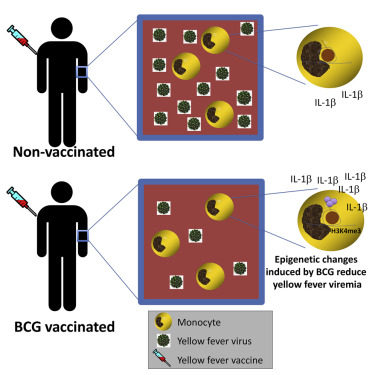
In this experiment, the yellow fever neutralizing antibody titer after 90 days of vaccination was not significantly different from that of BCG-free vaccination.
The "state in which immune cells tend to activate" is specifically a state in which histone proteins contained in monocyte chromatin (*5) activate genes, which can be determined by analyzing the genome sequence before and after BCG inoculation. The paper also argues that abnormal production of IL-1β may play a central role in inducing training immunity.
This paper does not validate against the COVID-19, but it does provide an example of how the BCG vaccine may be effective against a specific virus, and if we can see the similarity between FYV and the SARS-CoV2 virus, we may be able to say more with certainty.
How to recognize pathogens
Recognition by Pattern Recognition Receptors
The human body has the ability to recognize various bacteria and viruses that are lurking in the body and whether they are foreign or not. There are several types of PRRs, including Toll Like Receptors (TLRs) on the cell surface and intracellularly, and RIG-I-like Receptors (RLRs) intracellularly, which are known to accept viruses.

TLRs are classified into 11 types, among which TLR-7 and TLR-8 recognize single-stranded RNA viruses (*6, 7). These TLRs respond to the RNA or DNA of the virus rather than the virus itself.
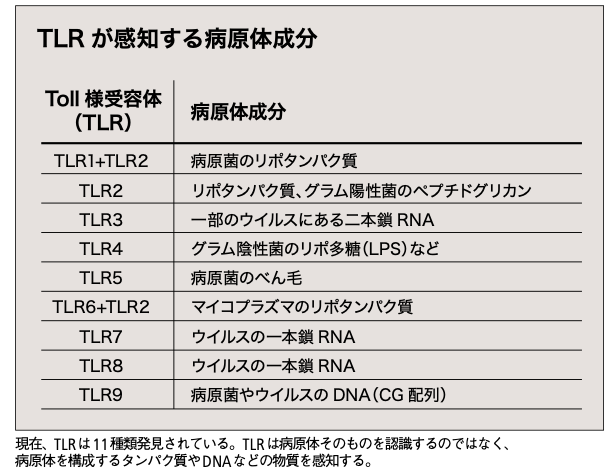
Dr. Hirano at Osaka University has reported that RIG-I and MDA5 are the mechanisms that recognize SARS-CoV antigens in innate immunity. It is also explained that ARDS is caused by a cytokine storm centered on IL-6. (*8)
Differences in characteristics between BCG strains
(1) Differences in ingredients between sub-strains
BCG was introduced from the Pasteur Institute in 1926, and subspecies are divided by country, with strain-specific gene deletions and mutations occurring during each country's own culture. The BCG Tokyo strain in Japan is based on the original bovine bile (M.bovis) and was distributed relatively old. Each subspecies has been found to have different bacteriological traits as shown in Table 1.
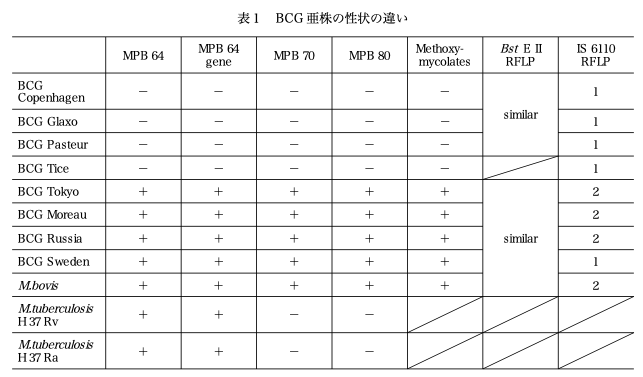
MPB and IS6110 and other gene regions called RDx (Region of Difference) remain in relatively old Tokyo/Moreau/Russia strains, while MPB and IS6110 and other gene regions called RDx remain in relatively old Tokyo/Moreau/Russia strains.
(2) Differences in epitopes
Another way to recognize pathogens is through epitopes. An epitope is the part of an antigen (protein) that an antibody recognizes, and usually one antigen has multiple epitopes. When an antigen is recognized by a T cell, the antigen is first incorporated into macrophages and antigen-presenting cells of B cells, where it is degraded into peptides. The processed peptides are presented to the T cell receptors and the T cells are activated. (*9)
In 2013, a Chinese research team looked at how BCG's genomic information and epitope counts differed from strain to strain of BCG. Out of a total of 483 T cell epitopes, older generation lines such as BCG Tokyo/Russia have been shown to have a higher number of epitopes. (*10)
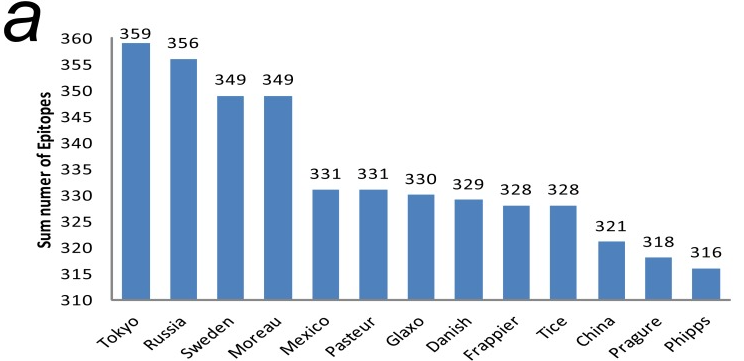
Does this mean that the number of epitopes contained in MPB is included in this group? The paper also suggests that the BCG Tokyo strain is the best candidate for use in better vaccine development.
Differences in immune response between sub-strains
How does the immune response change after inoculation with BCG, which has different characteristics depending on the strain as described above? Here are some papers that may be helpful. (*11)
This paper examines the immune response from peripheral blood mononuclear cells (PBMCs) collected one year after neonates were inoculated with BCG Brazil, BCG Denmark, and BCG Tokyo.
When the cytokines expressed were divided into three types, the BCG strains showed the following results.
| Type | Cytokine | BCG strain |
|---|---|---|
| Type I | IL-1α, IL-1β, IL-6, IL-24 | BCG Tokyo |
| Type II | IL-2β(IL-12β), IL-27, IFN-γ | BCG Brazil or BCG Denmark |
| Type III | TypeI cytokine+TypeII cytokine | BCG Denmark |
It is natural that BCG vaccination activates acquired immunity and produces various cytokines. From the above results, the following points are noteworthy.
The BCG Tokyo strain expresses IL-6, which is found in cytokine storms seen in cases of the COVID-19. (But IL-6 is not unique to the COVID-19.)
The BCG Tokyo strain expresses IL-1, which is produced by innate immunity. It's possible that he's boosting his natural immunity.
Memory cells in immunity
Memory T cells, memory B cells, and memory NK cells are known to be involved in the mechanism of recognizing and storing antigens.
Once a human being is directly exposed to an antigen, it recognizes and remembers the antigen, so that it can quickly prepare for an attack when the antigen comes again. It has been suggested that the vulnerability of young children to infection may be due to the lack of formation of this immune memory. In other words, "we have a lot of naïve cells that have no memory.
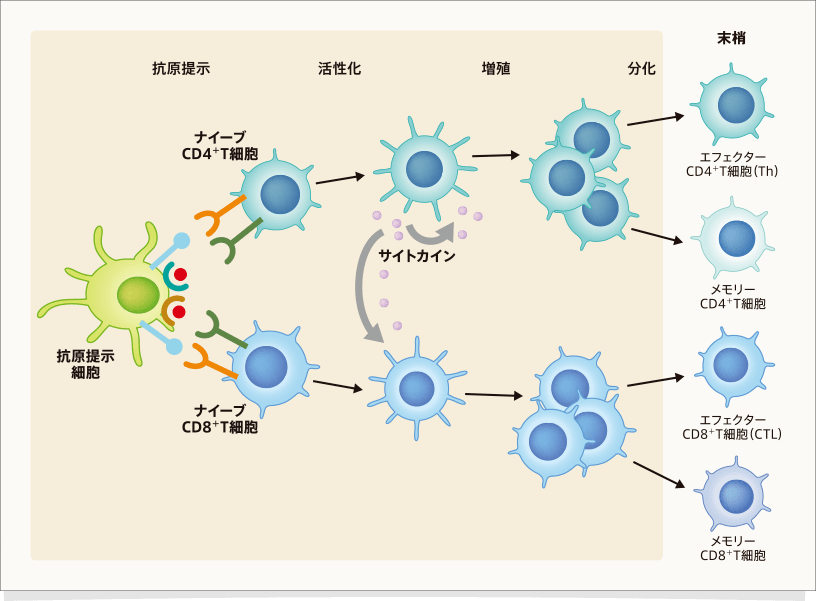
Diverse defense mechanisms against pathogens
In addition, CD4+ memory T cells are responsible for memory against antigens derived from the virus. Interestingly, when memory T cells respond to the influenza vaccine, they also respond to environmental antigens other than influenza, suggesting that CD4+ memory T cells have a broad antigen response (cross-reactivity is said to be high) and that vaccinees have many such memory T cells. (*12)
Naïve T cells take a few days to a week or more to respond to an antigen, but when memory cells are formed, an antigen response can occur in a few hours.
There are two types of memory B cells, high affinity and low affinity, which are more likely to respond to similar antigens than to specific antigens. These memory B cells are produced by helper T cells (*13). Memory B cells have been shown to be activated via IL-9, which may not be relevant because BCG inoculation does not produce IL-9.
Incidentally, studies have shown that BCG inoculation in adults sustains NK cell responses for a long period of time. (*14)
Possible hypothesis
Based on the above paper, a hypothesis will be developed to test the effect of BCG vaccine in reducing the severity of COVID-19.
People who have not received BCG first activate innate immunity, but either they cannot present antigens and do not produce antibodies, or their lymphocytes do not become activated after presentation of antigens and antibody production is delayed for more than a few days, resulting in rapid viral proliferation and a strong cytokine storm, which leads to severe disease.
After activation of innate immunity, memory T cells rapidly recognize antigens and activate lymphocytes to produce antibodies, which suppresses viral proliferation to a certain degree, and cytokine storms are moderately suppressed in BCG-treated patients, making them less susceptible to severe disease.
In addition to the above, people who have been inoculated with old strains such as BCG Tokyo rapidly produce IL-6, and innate and acquired immunity are activated almost simultaneously, stopping viral proliferation quickly, and cytokine storms are unlikely to occur. Some people will be cured without another rise in antibodies.
Although the above is the overall hypothesis, the following immunological events can be considered.
Hypothesis: What might happen in the case of BCG vaccination?
- A significant difference in the increase in cytokines such as IL-1β in blood monocytes of BCG-inoculated individuals was observed when the new coronavirus was administered to blood samples from BCG-inoculated or non-BCG-inoculated individuals.
- At the same time, cytokines in these monocytes are caused by the activation of lymphocytes such as memory T cells (CD4T system, CD8T system).
Hypothesis: What would happen if there is a difference in efficacy between different BCG sub-strains?
- Epitope analysis of BCG revealed similarity to the antigens of the new corona (which could be said to be prone to cross-reactions). In particular, many similar epitopes were found in BCG Tokyo strains especially MPB64, MPB70 and MPB80. (Would such similarities be known by analyzing the peptides in the epitope mapping?)
- There is a certain correlation between the index of similarity and the number of epitopes in Figure 1.
- In the BCG Tokyo strain, IL-6 expression activates Tfh (differentiated T cells that target B cells) and B cells at an early stage.
Although not all of the BCG hypotheses can be proven, I believe that experimentally confirming the above hypotheses will help to reinforce the BCG hypothesis. In particular, the long-term memory of the memory cells of lymphocytes and the memory mechanisms of innate immunity have been partially discovered, but the details are still not clear. It is hoped that these basic studies will lead to a better understanding of this phenomenon.
【References】
(※1-1) Association of BCG vaccination policy with prevalence and mortality of COVID-19
(※1-2) If I were North American/West European/Australian, I would take BCG vaccination now against the novel coronavirus pandemic.
(※2) Is BCG "effective" for COVID-19? Urgent Commentary by Professor Osumi of Tohoku University
(※3) Virological Characteristics and Mode of Infection of New Coronavirus Infections (COVID-19) (Kimiyasu Shiraki)
(※4) BCG Vaccination Protects against Experimental Viral Infection in Humans through the Induction of Cytokines Associated with Trained Immunity
(※5) Chromatin: a complex of DNA and protein found in eukaryotic cells.[1] Its primary function is packaging long DNA molecules into more compact, denser structures.
(※6) The front line of immune system
(※7) The "Toll-like receptors" that overturned the common sense of the immune system.
(※8) The Road to Overcoming COVID-19
(※9) Glossary:Antigen determinants (epitopes)
(※10) Genome Sequencing and Analysis of BCG Vaccine Strains
(※11) Unique Gene Expression Profiles in Infants Vaccinated with Different Strains of Mycobacterium bovis Bacille Calmette-Guérin
(※12) Virus-Specific CD4+ Memory-Phenotype T Cells Are Abundant in Unexposed Adults
(※13) ‘Distinct cellular pathways select germ-line encoded and somatically mutated antibodies into immunological memory’
The Journal of Experimental Medicine 2012, T.Kaji et al.
(※14) Bacillus Calmette−Guérin (BCG) Revaccination of Adults with Latent Mycobacterium tuberculosis Infection Induces Long-Lived BCG-Reactive NK Cell Response
【Reference books】

- 作者:田中 稔之
- 発売日: 2016/08/31
- メディア: 単行本
<※>Translated with www.DeepL.com/Translator (free version)
